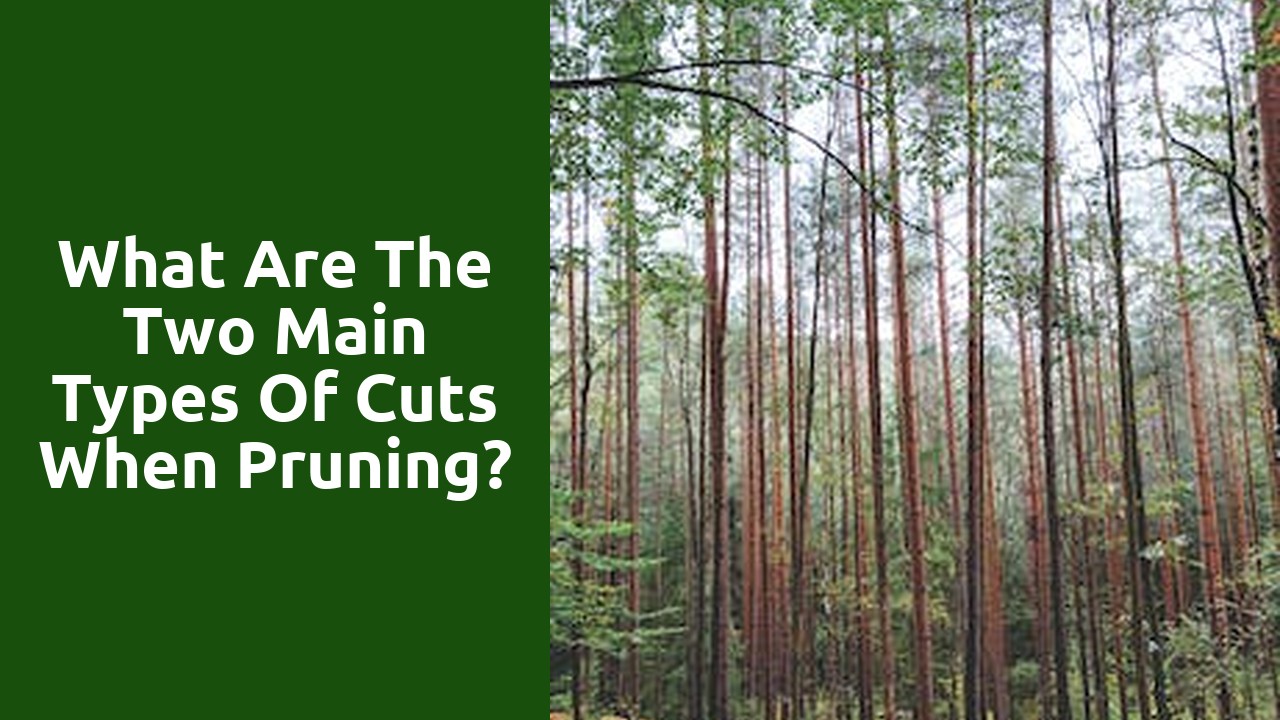What are the two main types of cuts when pruning?

Heading 1: Understanding Pruning Techniques
Pruning is an essential technique in horticulture and arboriculture that involves the selective removal of certain parts of a plant. Common objectives of pruning include shaping the plant, maintaining its health, and enhancing its overall appearance. Understanding the proper techniques for pruning is crucial for achieving desired outcomes and avoiding potential damage to the plant.
One fundamental technique in pruning is known as heading back. This method involves cutting back the terminal bud or main stem, which helps to promote lateral growth and create a fuller and bushier plant. Heading back is commonly used for shaping shrubs and hedges, as it encourages the growth of new branches and foliage in a controlled manner. However, it is important to remember to not remove too much foliage at once, as it can stress the plant and hinder its ability to recover.
Heading 2: The Purpose of Pruning
Proper pruning of plants is essential for maintaining their health and promoting their growth. One of the main purposes of pruning is to remove dead or diseased branches. These branches can become a breeding ground for pests and diseases, which can spread to other parts of the plant and eventually lead to its decline. By removing these branches, we can prevent the spread of infections and ensure the overall well-being of the plant.
Another purpose of pruning is to shape the plant and improve its appearance. Through strategic pruning, we can shape the plant to grow in a desired form or size. This is particularly important for ornamental plants, such as shrubs and hedges, where aesthetics play a significant role. By selectively removing certain branches, we can create a more visually appealing and symmetrical plant. Additionally, pruning can encourage the development of new growth, resulting in a denser and fuller plant.
Heading 2: Identifying the Target Branches
Properly identifying the target branches is a crucial step in any marketing or business strategy. Understanding which branches are the most suitable for targeting can greatly enhance the effectiveness of your campaigns and increase your chances of success. One way to identify the target branches is by conducting thorough market research. This involves analyzing data such as demographics, consumer behavior, and market trends to gain insights into which branches are most likely to be receptive to your products or services. By conducting this research, you can then strategically allocate your resources and tailor your marketing efforts to reach and resonate with your target audience.
Another effective way to identify the target branches is by leveraging customer feedback and insights. By actively listening to your existing customers and understanding their needs, preferences, and pain points, you can gain valuable insights into which branches are most likely to have a demand for your offerings. This can be achieved through methods such as surveys, customer interviews, or analyzing customer reviews and feedback. By incorporating this information into your targeting strategy, you can ensure that your marketing efforts are aligned with the needs and interests of your target audience, which can greatly increase the likelihood of successfully reaching and engaging with them.
Heading 2: Preparing for Pruning
Preparing for pruning is an essential step in maintaining the health and appearance of your plants. Firstly, it is important to gather the necessary tools for pruning, such as sharp and clean pruning shears or loppers. These tools will ensure clean cuts that promote the healing and growth of your plants. Additionally, it is advisable to wear protective gloves to safeguard your hands from potential cuts or scratches.
Next, before you start pruning, take a moment to examine each plant and determine the purpose of your pruning. Are you looking to remove dead or diseased branches, shape the plant for aesthetic reasons, or encourage new growth? Understanding your pruning goals will guide your pruning techniques. Additionally, it is crucial to research the specific pruning needs of each plant species in your garden, as different plants have different pruning requirements. This will help you identify the best time of year to prune and the specific techniques to employ to ensure optimal plant health.
Heading 2: Technique 1: Reduction Cut
The reduction cut is a popular technique used in various fields such as woodworking, sculpture, and even hairdressing. It involves gradually removing material or length from an object or structure to achieve the desired shape or form. This method requires precision and planning, as it is crucial to remove small amounts at a time to avoid over-cutting or compromising the integrity of the object. The reduction cut is often employed when working with large and solid materials, as it allows for greater control and accuracy in shaping and refining the end result. It is a process that requires patience and skill, but when executed successfully, it can produce impressive and visually pleasing outcomes.
Heading 2: Technique 2: Thinning Cut
A thinning cut is a popular haircutting technique that is often used to remove excess bulk and create more movement and texture in the hair. This technique involves strategically cutting small sections of hair shorter than the surrounding hair. By doing so, hairdressers can create a layered effect and achieve a more balanced and natural look.
Thinning cuts are particularly beneficial for people with thick or coarse hair. When done correctly, this technique can help reduce the weight and density of the hair, making it more manageable and easier to style. Additionally, thinning cuts can also add volume and body to the hair, giving it a more lightweight and airy appearance. Hairdressers often use specialized thinning shears or scissors with serrated edges to achieve the desired thinning effect without sacrificing too much length.
Related Links
What is the difference between cutting off and pruning?What does pruning remove?